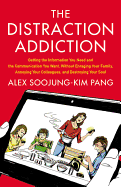
In The Distraction Addiction, Alex Soojung-Kim Pang investigates our susceptibility to digital interruption and suggests ways to practice more "contemplative computing." Pang, a futurist with a Ph.D. in the history of science, cites current productivity studies--and evidence of Stone Age adhesives--to distinguish synergistic multitasking (in which related activities converge toward a unified goal) over the deceptive bustle of switch-tasking (in which frequent toggling among unrelated activities plunders mental overhead). When we fracture our work "flow" by peeking at our in-boxes or Facebook walls or favorite news sites, we are switch-tasking, not multitasking.
Written in smooth prose, The Distraction Addiction does not break new ground but blends personal anecdote, summarized research and interviews to motivate readers to become the boss of their own tech. Pang offers myriad approaches to achieve brain-over-bytes control, including using "zenware" programs that declutter the onscreen workspace, observing a "digital Sabbath" and strengthening cognitive calm through breathing techniques and meditation. In one of his many interesting discursions, he describes Charles Darwin's garden at Sandwalk as a paragon of how "restorative environments and contemplative spaces" can help focus the mind.
More philosophical and eclectic than efficiency bibles like David Allen's Getting Things Done, the final section of The Distraction Addiction lays down Pang's principles of contemplative computing and rules for "mindful" social media use. Reading this manual of gentle intellectual persuasion may lead you to deploy your own digital resources in a more focused and intentional manner, assuming you can refrain from checking your e-mail long enough to absorb its lessons. --Holloway McCandless, blogger at Litagogo: A Guide to Free Literary Podcasts

